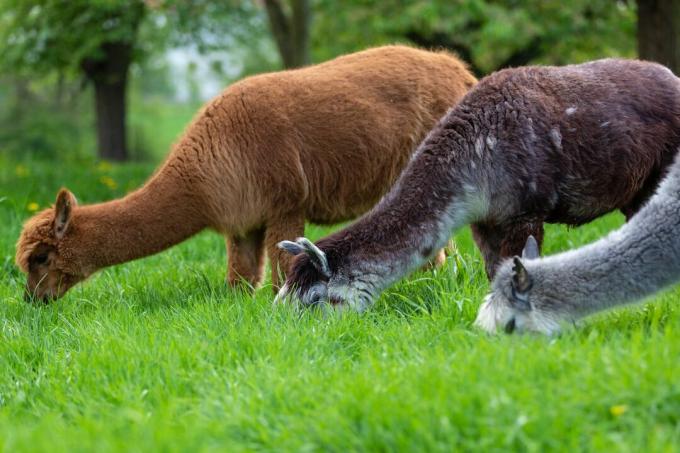The pampas grass needs enough nutrients for its rapid growth. We reveal what you have to consider when fertilizing pampas grass.

It is towering, even arrogant pampas grass (Cortaderia). The fast-growing plant is really impressive in autumn when the large inflorescences appear. In order for the pampas grass to develop well, a balanced supply of nutrients is of course crucial. As its name suggests, pampas grass originates from the vast grasslands of South America. There it feels particularly at home along streams or in other moist but very sunny locations. Below ground, the grass forms a rhizome - a perennial organ in which it can store nutrients and energy. The soils of the pampas are well suited for this because they are deep and rich in nutrients. And "nutrient-rich" is also the buzzword when it comes to fertilization in the following.
Fertilize pampas grass: When is the right time?
In the spring, the pampas grass starts growing after its winter break. Now is the best time to fertilize. A dose in late summer, on the other hand, would damage the frost-sensitive plant, since it would then no longer be able to mature properly before winter.

What should you fertilize pampas grass with?
A very special type of soil can be found in the pampas: It is very deep and mainly mineral, but due to the high level of activity of the soil organisms it is heavily interspersed with humus. If you want to do something good for your pampas grass, then you should follow this example. Organic fertilizers that promote soil life and humus build-up are therefore best suited. Also, beware of too much nitrogen. While this nutrient is essential for any plant, overdosing on tall grasses like pampas grass can be detrimental. The grass then loses stability and stability and also becomes more susceptible to cold and frost.
Remember that pampas grass not only thrives on its favorite soil, but increasingly so also areas disturbed by humans such as old industrial sites, railway tracks or roadsides populated. The soil there is often sandy and less nutrient-rich. Nevertheless, the grass also grows excellently on these soils and has developed into an invasive species in large parts of southern Europe without any fertilization. Very regular fertilization is therefore not important for the pampas grass. It is extremely easy to care for and can also cope with fewer nutrients. However, since you will most likely remove the dead leaves - unlike in the great outdoors - you are regularly withdrawing nutrients from the cycle. This loss has to be compensated from time to time.
notice: Grasses in pots, however, should be fertilized regularly, as they cannot spread their roots as far as they like. However, the pampas grass is clearly considered a specimen for beds.
Fertilizing pampas grass organically: the right approach
If you want to fertilize your pampas grass, then organic fertilizer is the method of choice. Either you use compost from your own garden, which you work into the soil in the spring when growth begins, or you rely on a primarily organic fertilizer like ours Plantura organic tomato fertilizer, which the plant gratefully accepts. This saves you the tiresome rearranging of your compost and you can easily work the fertilizer into the soil once in the spring.
Fertilize pampas grass with minerals
Mineral fertilization is actually not in the nature of pampas grass. In its homeland, it uses the nutrients released as organic matter decomposes. This happens gradually over the summer as it gets warm and humid. However, mineral fertilization is usually available quickly and does not last long. Soon the plant will have to be fertilized again and so you as a gardener are constantly busy fertilizing the most diverse plants. If it is to be mineral fertilizer, then it is better to use depot fertilizer with a moderate nitrogen content. This protects your nerves as well as the groundwater and also meets the needs of the plant.
Fertilize pampas grass with home remedies
Pampas grass is not very demanding, in fact it probably enjoys compost the most. The second variant, which perhaps comes closest to the natural environment of the grass, is manure. Wild horses and cattle live in the vast grasslands of South America, as do the wild relatives of llamas and alpacas, the guanaco (Lama guanicoe). Their nutrient-rich legacies can be found everywhere. If you want to fertilize your pampas grass in a particularly stylish way, then look out for an alpaca farmer in your area. He will certainly be happy to provide you with alpaca manure. And by the way: The dung of this camel species is probably one of the highest quality natural fertilizers, not only for pampas grass.

Fertilize pampas grass – the most important things in a nutshell:
- Thrives naturally on nutrient-rich and deep soil with a high humus content
- Can also develop very well on sandy and disturbed soils
- Fertilization makes sense from time to time, because the Cutting back the pampas grass stalks nutrients are withdrawn from the cycle
- fertilization in spring
- Only use fertilizers with a moderate nitrogen content
- Prefers compost, alpaca manure or organic fertilizers

